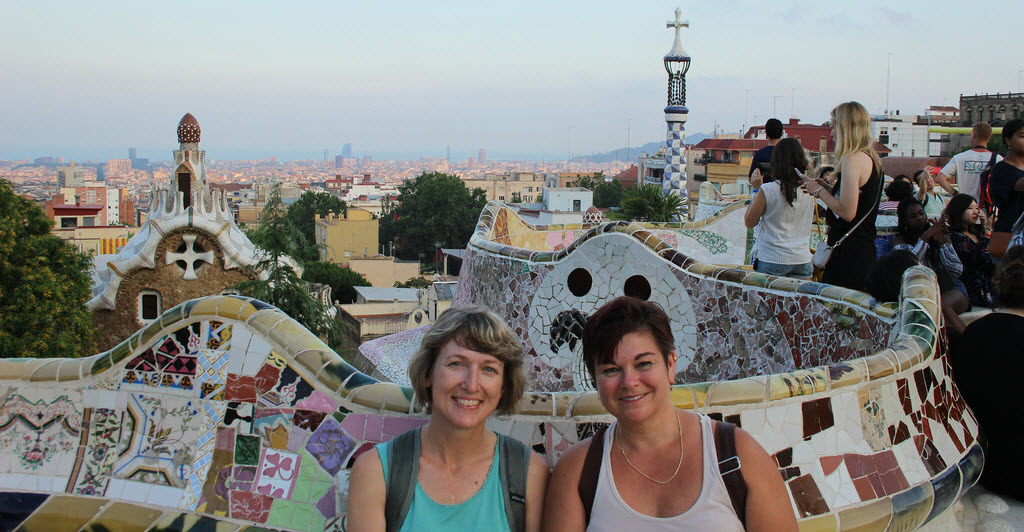What’s Worth Saving?


Researching the Trans-Saharan trade routes in Tangier, Morocco.
FFT Fellows take planes, trains and automobiles in pursuit of knowledge that will engage students. Kristie Blanchard and Christine Troup’s transportation of choice? Camels.
UNESCO World Heritage Sites can be hard to get to.
According to the United Nations Education, Scientific & Cultural Organization (UNESCO), World Heritage Sites are cultural and/or natural sites considered to be of ‘Outstanding Universal Value’ with special importance for everyone. Everyone, that is, except Kristie and Christine’s students at Bacon Academy in Colchester, CT.
“Our rural public high school lacks diversity and global acuity,” said the teaching team. “Freshmen also take a year-long geography course that lacks geospacial technologies used by professionals in the field. We designed our fellowship to explore iconic sites of Catalan, Andalusia and Morocco. Documenting the destinations with Geographic Information Systems (GIS) linked world cultures with geography to emphasize WHY these places have value.”
Taking their lead from the UNESCO theme “Protecting our Heritage and Fostering Creativity,” Christine and Kristie started their fellowship at the Creativity Workshop in Barcelona. There, they deepened proficiencies in the “Four C’s of Deeper Learning” outlined by the Partnership for 21st Century Skills: work collaboratively, improve communication, critical thinking and creativity.
Then, they set off for the Iberian Peninsula to interview citizens and learn from local guides and docents how UNESCO sites represent the cultural landscape of each unique region. Their odyssey took them to:
- Antoni Gaudi sites, including Sagrada Familia
- the Alhambra
- Alcazar of Seville
- El Torcal de Antequera, and
- the “Blue City” of Chefchaouen
The question that guided all of their research was “What makes a place worth preserving?”



Kristi and Christine began the school by addressing the lack of Middle Eastern and European elements in their curriculum. An ESRI Story Map documenting the fellowship models for students how technology can bridge information with authentic learning in multiple aspects of their lives and their community.
“In keeping with our fellowship’s guiding question, students will be challenged to find sites that they believe are worth preserving in our town,” said Kristie. “Through research, inquiry and writing, students may influence the Historic Preservation Office of Connecticut to add additional sites to their register.”
“We’re now able to make text-to-world applications through our experiences and gathered artifacts,” added Christine. “By using new techniques, all students, including those who read and write below proficiency level, will be encouraged to participate in more personalized ways to tell their authentic stories, as well as those of our community.”
[minti_divider style=”1″ icon=”” margin=”20px 0px 20px 0px”]
 Christine Troup has taught grades 6 – 12 in three states over the past 23 years. In her free time, she enjoys reading, writing, and traveling, or any combination of the three. Kristie Blanchard has specialized in teaching 9th grade Geography and 10th grade AP Human Geography for nearly 20 years. Her career accomplishments include: the National Council for Geographic Education Distinguished Teaching Award, New England St. Lawrence Valley Geographical Society’s Friend of Geography Award, and the American Geographical Society Teacher Fellow.
Christine Troup has taught grades 6 – 12 in three states over the past 23 years. In her free time, she enjoys reading, writing, and traveling, or any combination of the three. Kristie Blanchard has specialized in teaching 9th grade Geography and 10th grade AP Human Geography for nearly 20 years. Her career accomplishments include: the National Council for Geographic Education Distinguished Teaching Award, New England St. Lawrence Valley Geographical Society’s Friend of Geography Award, and the American Geographical Society Teacher Fellow.
 Back to Blogs
Back to Blogs